Points
-
319 Tb/s long-haul transmission of wideband (>120 nm) S, C and L-bands signal using 552 PDM-16QAM, wavelength-division multiplexed channels in a 4-core optical fiber
-
Long-distance transmission over 3,001 km enabled by adoption of both erbium and thulium doped-fiber amplifiers and distributed Raman amplification
-
Demonstration shows potential of SDM fibers with standard-cladding diameter and compatibility with existing cabling technologies for near-term adoption of high-throughput SDM fiber systems
Researchers from the National Institute of Information and Communications Technology (NICT, President: TOKUDA Hideyuki, Ph.D.), Network Research Institute, succeeded the first S, C and L-bands transmission over long-haul distances in a 4-core optical fiber with standard outer diameter (0.125 mm). The researchers, lead by Benjamin J. Puttnam, constructed a transmission system that makes full use of wavelength division multiplexing technology by combining different amplifier technologies, to achieve a transmission demonstration with date-rate of 319 terabits per second, over a distance of 3,001 km. Using a common comparison metric of optical fiber transmission the data-rate and distance produce of 957 petabits per second x km, is a world record for optical fibers with standard outer diameter.
In this demonstration, in addition to the C and L-bands, typically used for high-data-rate, long-haul transmission, we utilize the transmission bandwidth of the S-band, which has not yet been used for further than single span transmission. The combined >120nm transmission bandwidth allowed 552 wavelength-division multiplexed channels by adopting 2 kinds of doped-fiber amplifier together with distributed Raman amplification, to enable recirculating transmission of the wideband signal. The standard cladding diameter, 4-core optical fiber can be cabled with existing equipment, and it is hoped that such fibers can enable practical high data-rate transmission in the near-term, contributing to the realization of the backbone communications system, necessary for the spread of new communication services Beyond 5G.
The results of this experiment were accepted as a post-deadline paper presentation at the International Conference on Optical Fiber Communications (OFC 2021).
Background
Over the past decade, intensive research has been carried out worldwide to increase the data rates in optical transmission systems using space-division multiplexing as a means to meet the exponentially increasing demand for optical data transmission. More recently, interest in fibers with the same 125 µm cladding diameter as standard single-mode fibers has grown due to their compatibility with conventional cabling infrastructure and concerns over the mechanical reliability of larger fibers. Particularly with multi-core fibers (MCFs), reducing the cladding diameter limits the number of spatial channels, leading to increasing interest in combining such fibers with wider transmission bandwidths in order to meet the expected growth in transmission capacity expected in SDM fibers. Until now, NICT has built various transmission systems that make use of wavelength division multiplexing across the C and L-bands together with state-of-the-art modulation technology to explore high data-rate transmission in a range of new optical fibers. Recently, NICT and research groups around the world have begun to explore S-band transmission, leading to several new records for transmission capacity in optical fibers, but transmission distance has been limited to only a few tens of kilometers.
Achievements
NICT has built a long-distance transmission system around a 4-core optical fiber with a standard cladding diameter to exploit wider transmission bandwidth of >120nm across S, C and L-bands. The system exploits wavelength division multiplexing (WDM) and a combination of optical amplification technology to enable long-haul transmission of 552 WDM channels from 1487.8 nm to 1608.33 nm. The system was used to measure achievable transmission throughput with each channel modulated with PDM-16QAM modulation at distances up to 3,001 km, where a data-rate of 319 terabits per second was achieved. This result may be compared to achievements in other SDM fibers and transmission regimes by calculating the product of transmission capacity and distance, often used as a comparison metric. The data-rate x distance product becomes 957 petabits per second x km, which is over 2.7 times larger than previous demonstrations in SDM fibers with standard outer diameter.
Long distance transmission, not previously demonstrated with S-band signals, was enabled by constructing a recirculating transmission loop experimental set-up that combined 2 kinds of rare-earth doped fiber amplifiers with Raman amplification distributed along the transmission fiber itself.
The 4-core MCF with standard cladding diameter is attractive for early adoption of SDM fibers in high-throughput, long-distance links, since it is compatible with conventional cable infrastructure and expected to have mechanical reliability comparable to single-mode fibers. Beyond 5G, an explosive increase from new data services is expected and it is therefore crucial to demonstrate how new fibers can meet this demand. Hence, it is hoped that this result will help the realization of new communication systems that can support new bandwidth hungry services.
Future Prospects
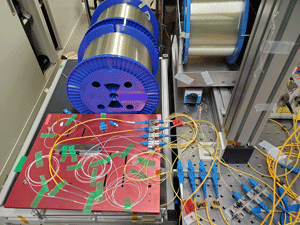
Fig. 2 Part of the transmission system this time (Raman amplification section)
NICT will continue to develop wide-band, long-distance transmission systems and explore how to further increase transmission capacity of low-core-count multi-core fibers and other novel SDM fibers. Further, we will work to extend the transmission range to trans-oceanic distances.
The paper containing the results of this experiment was published at the International Conference on Optical Fiber Communication ((OFC2021, June 6 (Sun) to June 11 (Fri)), one of the largest international conferences related to optical fiber communication, this year held virtually due to Corona virus travel restrictions. It was highly evaluated and was presented in the Post Deadline session, known for release of latest important research achievements on June 11 (Fri) 2021 local time.
References
International Conference: International Conference on Optical Fiber Communications (OFC 2021) Post Deadline Paper
Title: 319 Tb/s Transmission over 3001 km with S, C and L band signals over >120nm bandwidth in 125 μm wide 4-core fiber
Authors: Benjamin J. Puttnam, Ruben S. Luís, Georg Rademacher, Yoshinari Awaji, and Hideaki Furukawa
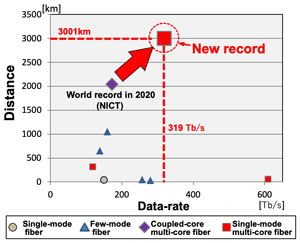
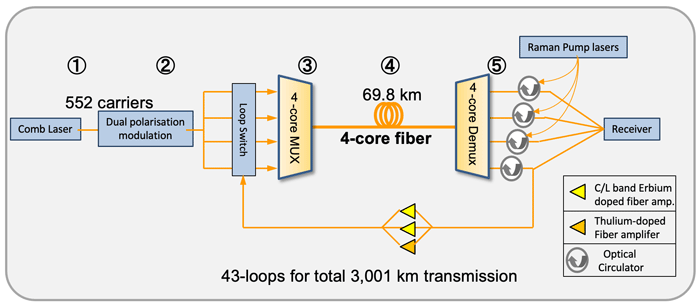
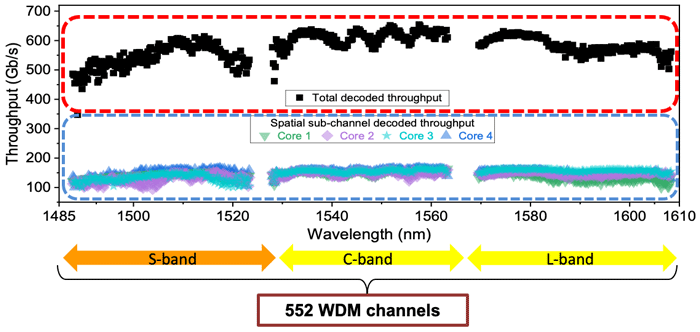
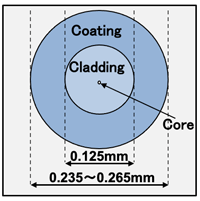

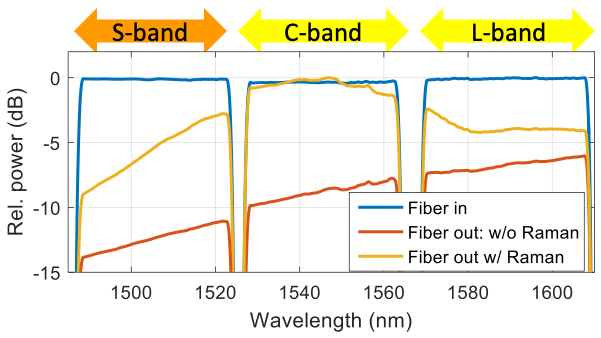
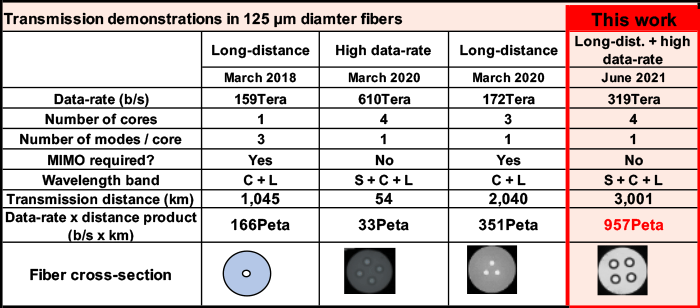
 ml.nict.go.jp
ml.nict.go.jp